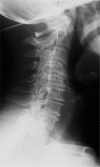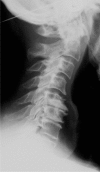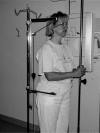The association between cervical spine curvature and neck pain
- PMID: 17115202
- PMCID: PMC2213543
- DOI: 10.1007/s00586-006-0254-1
The association between cervical spine curvature and neck pain
Abstract
Degenerative changes of the cervical spine are commonly accompanied by a reduction or loss of the segmental or global lordosis, and are often considered to be a cause of neck pain. Nonetheless, such changes may also remain clinically silent. The aim of this study was to examine the correlation between the presence of neck pain and alterations of the normal cervical lordosis in people aged over 45 years. One hundred and seven volunteers, who were otherwise undergoing treatment for lower extremity problems in our hospital, took part. Sagittal radiographs of the cervical spine were taken and a questionnaire was completed, enquiring about neck pain and disability in the last 12 months. Based on the latter, subjects were divided into a group with neck pain (N = 54) and a group without neck pain (N = 53). The global curvature of the cervical spine (C2-C7) and each segmental angle were measured from the radiographs, using the posterior tangent method, and examined in relation to neck complaints. No significant difference between the two groups could be found in relation to the global curvature, the segmental angles, or the incidence of straight-spine or kyphotic deformity (P > 0.05). Twenty-three per cent of the people with neck pain and 17% of those without neck pain showed a segmental kyphosis deformity of more than 4 degrees in at least one segment--most frequently at C4/5, closely followed by C5/6 and C3/4. The average segmental angle at the kyphotic level was 6.5 degrees in the pain group and 6.3 degrees in the group without pain, with a range of 5-10 degrees in each group. In the group with neck pain, there was no association between any of the clinical characteristics (duration, frequency, intensity of pain; radiating pain; sensory/motor disturbances; disability; healthcare utilisation) and either global cervical curvature or segmental angles. The presence of such structural abnormalities in the patient with neck pain must be considered coincidental, i.e. not necessarily indicative of the cause of pain. This should be given due consideration in the differential diagnosis of patients with neck pain.
Figures





Comment in
-
Letter to the editor: "The association between cervical spine curvature and neck pain (D. Grob et al.)".Eur Spine J. 2007 Oct;16(10):1739-40; author reply 1741-3. doi: 10.1007/s00586-007-0382-2. Epub 2007 May 8. Eur Spine J. 2007. PMID: 17486375 Free PMC article. No abstract available.
References
-
- Albers D (1954) Eine Studie über die Funktion der Halswirbelsäule bei dorsaler und ventraler Flexion. Fortschr Geb Röntgenstr 81:606–615 - PubMed
-
- Boden SD, McCowin PR, Davis DO, Dina TS, Mark AS, Wiesel S. Abnormal magnetic-resonance scans of the cervical spine in asymptomatic subjects. A prospective investigation. J Bone Joint Surg Am. 1990;72(8):1178–1184. - PubMed
MeSH terms
LinkOut - more resources
Full Text Sources
Medical
Research Materials
Miscellaneous

